What is ‘snagging’ and the ‘defects period’?
You may have heard your architect talk of the ‘snagging’ and ‘defects period’ but not known what he or she meant. Here’s a brief overview for those to polite to ask.
Understanding ‘snagging’
‘Snagging’ is the process of identifying unsatisfactory or outstanding work (‘snags’) at the practical completion of a carpentry or building project. An inspection is usually carried out by the building supervisor or architect prior to handover to the customer. If there are problems, they would normally produce a ‘snag list’ and organise a ‘snag repair schedule’.
So, for example, some wood may have started to crack or a socket cover may not have been fitted in your kitchen. The building foreman would note down these snags and organize for the carpenter and electrician to return to the site to complete the work. Clients would not normally pay for this work, unless the problem was caused by something other than defective workmanship or materials.

Spot the snag?
‘Defects period’ definition
On big projects, once the unsatisfactory work had been rectified, the building would usually be inspected again after 3 to 12 months. This time, between snagging and reinspection, is called the ‘defects period’ and would be specified in the building contract. For small jobs there are no defects periods, but a good carpenter and joiner should come back to fix problems regardless of an agreement.
For carpenters and joiners in Shrewsbury, please contact our office for ethical carpentry and joinery work throughout Shropshire.
Have further carpentry questions? Post these below and we’ll try to answer them



0 Comments